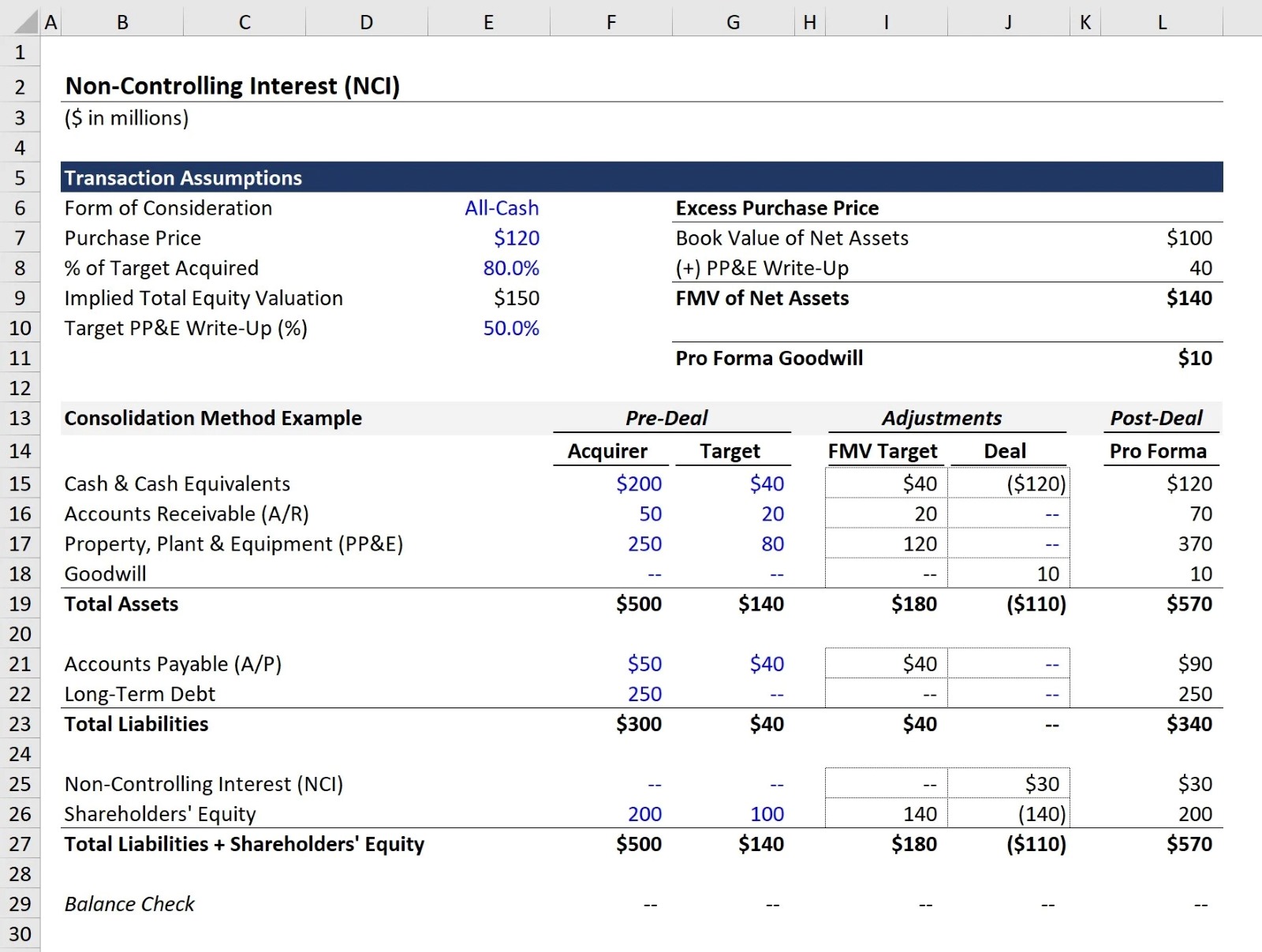

Finance
What Are Accounting Controls
Published: October 10, 2023
Learn about the importance of accounting controls in finance and how they help businesses mitigate risk, prevent fraud, and ensure accurate financial reporting.
(Many of the links in this article redirect to a specific reviewed product. Your purchase of these products through affiliate links helps to generate commission for LiveWell, at no extra cost. Learn more)
Table of Contents
Introduction
Welcome to the world of accounting controls, where financial stability and accountability come together. In the dynamic realm of finance, ensuring that businesses maintain accurate and reliable financial records is paramount. Accounting controls serve as the foundation for maintaining this integrity, providing a framework to safeguard against fraud, errors, and misuse of funds.
In simple terms, accounting controls refer to the policies, procedures, and practices implemented within an organization to safeguard its financial resources, promote compliance with laws and regulations, and maintain the accuracy and reliability of financial information. These controls encompass a broad spectrum of activities, including the establishment of internal controls, risk assessment, information and communication systems, and continuous monitoring.
The implementation of sound accounting controls is vital for businesses of all sizes and industries. Without adequate controls in place, organizations run the risk of financial mismanagement, non-compliance, and even reputational damage. By creating a robust control environment, businesses can instill confidence in their stakeholders, including investors, creditors, and regulatory bodies.
This comprehensive guide will delve into the world of accounting controls, exploring their importance, types, and key components. Whether you are a business owner, manager, or finance professional, understanding and implementing effective controls will contribute to the overall success and sustainability of your organization.
Definition of Accounting Controls
Accounting controls encompass the policies, procedures, and practices established within an organization to ensure that financial transactions are accurately recorded, processed, and reported. These controls are designed to mitigate the risks of fraud, errors, and misstatements, and to promote the overall reliability of financial information.
At its core, accounting controls serve as a system of checks and balances within an organization. They are implemented to provide reasonable assurance that financial records are complete, accurate, and in compliance with applicable laws and regulations. By implementing accounting controls, organizations can maintain the integrity of their financial information, safeguard their assets, and demonstrate accountability to stakeholders.
Accounting controls are typically divided into two main categories: preventive controls and detective controls.
- Preventive controls are measures that are put in place to prevent errors and fraud from occurring in the first place. These controls include segregation of duties, authorization procedures, physical safeguards, and employee training.
- Detective controls, on the other hand, are designed to identify errors and fraud after they have occurred. Examples of detective controls include regular internal audits, reconciliations, and variance analysis.
Effective accounting controls involve a combination of preventive and detective measures that are tailored to the specific needs and risks of an organization. It is important to note that accounting controls are not a one-size-fits-all solution. They should be customized and continuously evaluated to address evolving risks and changes in the business environment.
By implementing robust accounting controls, organizations can enhance the accuracy and reliability of their financial information, detect and prevent fraud, comply with legal and regulatory requirements, and ultimately foster trust and confidence among their stakeholders.
Importance of Accounting Controls
Accounting controls play a crucial role in the financial management of organizations. They are essential for ensuring the accuracy, reliability, and integrity of financial information. Let’s explore some key reasons why accounting controls are important:
- Preventing fraud and errors: One of the primary objectives of accounting controls is to prevent and detect fraud and errors. By implementing a system of checks and balances, organizations can identify and address any irregularities or discrepancies in their financial records.
- Safeguarding assets: Accounting controls help protect the organization’s assets, including cash, inventory, and equipment. By implementing physical security measures, such as restricted access and inventory tracking, organizations can reduce the risk of theft and misuse of assets.
- Compliance with laws and regulations: Accounting controls ensure that organizations are adhering to relevant laws and regulations. By implementing control activities, such as segregation of duties and authorization procedures, organizations can demonstrate compliance and avoid legal and regulatory penalties.
- Enhancing financial reporting: Accounting controls contribute to the accuracy and reliability of financial reports. By implementing control activities, such as reconciliations and variance analysis, organizations can identify and correct any errors or misstatements, thereby enhancing the quality of their financial reporting.
- Promoting transparency and accountability: Accounting controls foster transparency and accountability within organizations. By maintaining accurate financial records and implementing control measures, organizations can demonstrate their commitment to ethical business practices and build trust with stakeholders.
In addition to these benefits, accounting controls also provide opportunities for continuous improvement. By regularly evaluating and refining control activities, organizations can adapt to changes in the business environment and address emerging risks. This proactive approach helps organizations stay ahead in a rapidly evolving financial landscape.
In summary, accounting controls are essential for maintaining financial stability, preventing fraud and errors, safeguarding assets, ensuring compliance, enhancing financial reporting, and promoting transparency and accountability. By implementing robust accounting controls, organizations can mitigate risks, build trust, and pave the way for sustainable growth and success.
Types of Accounting Controls
Accounting controls can be classified into various types, each serving a specific purpose in ensuring the accuracy, reliability, and integrity of financial information. Let’s explore some of the most common types of accounting controls:
- Preventive Controls: These controls are designed to prevent errors, fraud, and misuse of funds. Examples of preventive controls include segregation of duties, authorization procedures, physical safeguards, and employee training. By implementing preventive controls, organizations can reduce the likelihood of fraudulent activities and errors occurring in the first place.
- Detective Controls: Detective controls are used to identify errors and fraud after they have occurred. Regular internal audits, reconciliations, and variance analysis are some examples of detective controls. These controls help organizations detect and address any irregularities or discrepancies in their financial records.
- Entity-Level Controls: Entity-level controls are overarching controls that set the tone for the entire organization. They include elements such as the organization’s ethical values, tone at the top, and the control environment. These controls influence the effectiveness of all other accounting controls in the organization.
- Transaction-Level Controls: These controls are specific to individual financial transactions. They are designed to ensure the accuracy, completeness, and validity of transactions. Examples of transaction-level controls include proper authorization, documentation, and review of transactions.
- IT Controls: In today’s digital age, information technology (IT) controls are crucial to protect financial information and data integrity. IT controls include measures such as access controls, data backups, and system monitoring to prevent unauthorized access, data loss, and breaches.
- Financial Reporting Controls: These controls focus on the accuracy and reliability of financial reporting. They include activities such as account reconciliations, financial statement reviews, and disclosure controls. Financial reporting controls ensure that financial information is complete, accurate, and in accordance with applicable accounting standards.
It is important to note that the specific types of accounting controls implemented by an organization may vary depending on its size, industry, and unique risks. A comprehensive approach to accounting controls involves a combination of preventive and detective controls, entity-level and transaction-level controls, as well as IT and financial reporting controls.
By implementing a well-rounded set of accounting controls, organizations can establish a robust control environment and safeguard their financial resources, mitigate risks, and ensure the accuracy and integrity of their financial information.
Internal Control Environment
The internal control environment is the foundation of an organization’s accounting controls. It encompasses the tone, culture, and mindset established by management regarding the importance of internal controls and ethical behavior. A strong internal control environment sets the tone for the entire organization, promoting accountability, integrity, and transparency.
There are several key components of an effective internal control environment:
- Tone at the Top: The tone set by senior management and the board of directors influences the overall control environment. When management demonstrates a commitment to ethical behavior, compliance with laws and regulations, and the importance of internal controls, it establishes a positive tone throughout the organization.
- Code of Ethics: A code of ethics outlines the values, principles, and standards of conduct expected from employees. It provides guidance on ethical behavior and serves as a reference point for decision-making. A well-defined and communicated code of ethics reinforces the internal control environment.
- Management’s Risk Assessment: Management should identify and assess the risks faced by the organization. This includes evaluating both internal and external factors that may impact the achievement of objectives. By understanding the risks, management can implement appropriate control activities to mitigate them.
- Commitment to Competence: Management should ensure that employees have the necessary skills and competencies to carry out their roles effectively. This includes providing training, development opportunities, and resources to support employees in performing their duties in accordance with internal controls.
- Effective Communication: Open and effective communication channels are essential for a strong internal control environment. Communication should flow both vertically and horizontally within the organization, ensuring that control objectives, responsibilities, and expectations are clearly communicated to all stakeholders.
- Ongoing Monitoring: Regular monitoring and review of internal controls are crucial to assess their effectiveness and identify any gaps or deficiencies. This includes internal audits, management reviews, and self-assessments. Monitoring enables management to take corrective actions and continuously improve the internal control environment.
By fostering a strong internal control environment, organizations can create a culture of accountability, integrity, and transparency. It sets the stage for the implementation of control activities, risk assessment, information and communication, and monitoring and reviewing processes, which collectively contribute to a robust system of accounting controls.
Control Activities
Control activities are the specific policies, procedures, and practices implemented within an organization to mitigate risks and ensure the effectiveness of accounting controls. These activities serve as the frontline defenses against fraud, errors, and other financial risks. They are designed to provide reasonable assurance that objectives are achieved and that financial records are accurate, reliable, and in compliance with applicable laws and regulations.
There are several key control activities that organizations commonly implement:
- Segregation of Duties: Segregation of duties involves separating key tasks and responsibilities to reduce the risk of errors and fraud. By dividing tasks among different individuals or departments, organizations establish checks and balances, ensuring that no single person has complete control over a process from beginning to end.
- Authorization Procedures: Authorization procedures require proper approval and oversight for financial transactions and actions. This ensures that only authorized individuals can initiate or approve transactions, minimizing the risk of unauthorized activities.
- Physical Controls: Physical controls involve measures to safeguard physical assets, such as cash, inventory, and equipment. This may include locked storage areas, security cameras, and access controls to restrict access to sensitive areas.
- Reconciliation and Review: Regular reconciliations of financial records, such as bank reconciliations and balance sheet reconciliations, help identify any discrepancies or errors. Reviews of financial statements and analytical procedures can also detect anomalies and inconsistencies that require further investigation.
- Documentation and Recordkeeping: Proper documentation and recordkeeping ensure that transactions and events are adequately recorded and supported. This includes maintaining accurate and complete financial records, such as invoices, receipts, and general ledger entries.
- Employee Training and Awareness: Training programs and ongoing employee awareness initiatives help educate staff about their roles and responsibilities in maintaining effective accounting controls. This includes training on fraud prevention, internal control procedures, and ethical behavior.
It is important to note that control activities should be tailored to the specific needs and risks of each organization. The extent and nature of control activities may vary depending on factors such as the size of the organization, industry, and regulatory requirements.
By implementing appropriate control activities, organizations can mitigate risks, detect and prevent errors and fraud, ensure compliance with laws and regulations, and enhance the accuracy and reliability of their financial information.
Risk Assessment
Risk assessment is a critical component of effective accounting controls. It involves the identification, analysis, and evaluation of risks that may impact the achievement of an organization’s objectives. By conducting a risk assessment, organizations can gain a comprehensive understanding of the potential risks they face and implement appropriate control measures to mitigate them.
The risk assessment process typically involves the following steps:
- Identify Risks: The first step is to identify potential risks that may affect the organization’s financial stability and integrity. This includes both internal risks, such as inadequate segregation of duties or lack of internal controls, and external risks, such as changes in economic conditions or regulatory requirements.
- Analyze Risks: Once risks are identified, they need to be analyzed in terms of their likelihood and potential impact. This involves assessing the probability of risks occurring and the potential magnitude of their consequences. This analysis helps prioritize risks and allocate resources effectively.
- Evaluate Risks: In this step, risks are evaluated based on their significance and potential impact on the organization’s objectives. This evaluation helps determine the level of risk tolerance and guides the development of control activities to mitigate the identified risks.
- Develop Risk Response: Based on the assessment and evaluation of risks, organizations develop risk response strategies. These strategies may involve implementing additional control activities, transferring risk through insurance or contracts, accepting the risk, or avoiding the risk altogether.
- Monitor and Review: Risk assessment is not a one-time exercise, but an ongoing process. Organizations should continuously monitor and review the effectiveness of control measures and the changing risk landscape. Regular reviews ensure that risk assessment remains up to date and aligned with the evolving business environment.
Through the risk assessment process, organizations can proactively identify and address potential vulnerabilities and threats. It enables management to focus resources on high-risk areas and prioritize control activities accordingly.
Risk assessment is closely linked to the other components of accounting controls, such as control activities and monitoring. By integrating risk assessment into the overall control framework, organizations can establish a robust system that provides reasonable assurance regarding the achievement of objectives and the integrity of financial information.
Information and Communication
Effective information and communication processes are essential for ensuring the success of accounting controls. They enable the accurate and timely flow of information within an organization, supporting the implementation and monitoring of control activities. Information and communication systems help ensure that the right information is available to the right people at the right time, facilitating informed decision-making and promoting transparency.
Here are some key aspects of information and communication in the context of accounting controls:
- Reliable and Accurate Information: The foundation of effective accounting controls lies in the availability of reliable and accurate information. Organizations should establish processes to ensure the accuracy and integrity of financial data, including periodic reconciliations, data validation checks, and proper documentation.
- Record Retention: Maintaining proper records and documentation is crucial for transparency and compliance. Organizations should establish policies for record retention to ensure that relevant information is retained for a specific period. This not only facilitates effective control implementation but also supports audit and regulatory requirements.
- Information System Controls: Information technology controls help safeguard the confidentiality, integrity, and availability of data. These controls include access controls, data backups, and system monitoring. By implementing robust IT controls, organizations can mitigate the risk of unauthorized access, data loss, and security breaches.
- Effective Communication Channels: Open and effective communication channels are vital for information to flow to the right individuals within the organization. This includes clear reporting lines, regular meetings, and channels for reporting concerns or anomalies. Communication should be transparent, ensuring that relevant information is shared with appropriate stakeholders.
- Training and Awareness: Proper training programs and ongoing awareness initiatives help ensure that employees understand their roles and responsibilities in the control environment. This includes training on control procedures, data confidentiality, and ethical behavior. Regular communication and training efforts promote a culture of compliance and accountability.
- External Communication: Effective communication extends beyond the organization’s internal stakeholders. Organizations should establish mechanisms to communicate relevant financial information to external parties, such as investors, regulators, and creditors. This includes financial reporting, disclosures, and transparency in financial statements.
By establishing robust information and communication processes, organizations can ensure that important financial information is accurately recorded, shared with relevant stakeholders, and used for decision-making. It helps promote transparency, accountability, and integrity, strengthening the overall effectiveness of accounting controls.
Monitoring and Reviewing
Monitoring and reviewing are integral components of effective accounting controls. They involve ongoing assessments to ensure that control activities are operating efficiently and effectively, and to identify any gaps or deficiencies that need to be addressed. Through regular monitoring and reviewing, organizations can maintain the integrity of their accounting controls and respond promptly to changes in the business environment.
Here are some key aspects of monitoring and reviewing in the context of accounting controls:
- Internal Audit: Internal audit plays a crucial role in monitoring and reviewing accounting controls. Internal auditors conduct independent assessments of the organization’s financial processes, internal controls, and compliance with policies and regulations. Their objective is to provide an unbiased evaluation of control effectiveness and identify areas for improvement.
- Management Review: Regular management reviews allow the organization’s leadership to evaluate the overall effectiveness of accounting controls and address any emerging risks or control deficiencies. This involves reviewing financial reports, control activities, risk assessment findings, and internal audit reports. Management can make informed decisions based on these reviews to enhance control strategies and mitigate risks.
- Self-Assessment: Self-assessment involves periodic evaluations conducted by business unit managers or process owners to assess the effectiveness of control measures within their specific areas. This allows for a decentralized approach to monitoring and reviewing, fostering accountability and ownership of control activities.
- Corrective Actions: Monitoring and reviewing serve as the foundation for identifying control deficiencies and taking corrective actions. This may involve revising control procedures, enhancing training programs, or implementing additional control activities to address identified weaknesses. Timely corrective actions help maintain the effectiveness of accounting controls.
- Compliance Monitoring: Monitoring and reviewing also encompass ensuring compliance with laws, regulations, and internal policies. This may involve periodic assessments, such as compliance audits, to ensure that the organization is operating in accordance with relevant legal and regulatory requirements.
- Continuous Improvement: The monitoring and reviewing process is not a one-time event but a continuous effort. Organizations should establish a culture of continuous improvement, where lessons learned from monitoring activities are used to enhance control measures. This includes identifying emerging risks, staying abreast of changes in regulations, and updating control activities as needed.
By implementing robust monitoring and reviewing processes, organizations can stay proactive in their approach to accounting controls. It helps identify control deficiencies, ensure compliance, and continuously enhance the effectiveness of control activities to mitigate risks, improve financial reporting, and foster a culture of accountability.
Conclusion
Accounting controls are the backbone of financial stability and integrity within organizations. They provide the framework for safeguarding assets, promoting compliance with laws and regulations, and ensuring the accuracy and reliability of financial information. Effective accounting controls involve a combination of preventive and detective measures tailored to the unique risks and needs of each organization.
In this comprehensive guide, we explored various aspects of accounting controls, including their definition, importance, types, and key components. We discussed how a strong internal control environment sets the tone for the entire organization, establishing a culture of accountability and transparency.
We delved into the different types of accounting controls, such as preventive controls, detective controls, entity-level controls, transaction-level controls, IT controls, and financial reporting controls. Each type plays a vital role in mitigating risks and ensuring the accuracy and reliability of financial information.
We also examined the significance of risk assessment in accounting controls, emphasizing the importance of identifying, analyzing, and evaluating risks to inform the implementation of control measures.
Furthermore, we explored how effective information and communication processes support the flow of accurate and timely information, aiding informed decision-making and promoting transparency within organizations.
Lastly, we discussed the vital role of monitoring and reviewing in maintaining the integrity of accounting controls. Regular assessments, internal audits, management reviews, and self-assessments help identify deficiencies and areas for improvement, enabling organizations to take corrective actions and continuously enhance their control environment.
In conclusion, accounting controls are crucial for organizations of all sizes and industries. By implementing robust control measures, organizations can mitigate risks, prevent fraud and errors, comply with regulations, enhance financial reporting, and foster a culture of accountability and transparency. Developing and maintaining effective accounting controls is an ongoing process that requires a proactive approach, continuous monitoring, and a commitment to continuous improvement.














